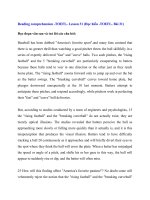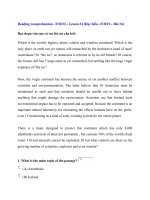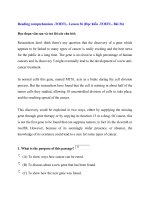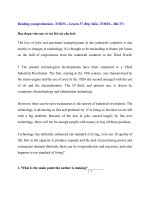Đọc hiểu -TOEFL- Bài 26 pdf
Bạn đang xem bản rút gọn của tài liệu. Xem và tải ngay bản đầy đủ của tài liệu tại đây (73.5 KB, 7 trang )
Reading comprehension -TOEFL- Lesson 26 (Đọc hiểu -TOEFL- Bài 26)
Đọc đoạn văn sau và trả lời các câu hỏi:
The rules of etiquette in American restaurants depend upon a number of factors the
physical location of the restaurant, e.g., rural or urban; the type of restaurant, e.g.,
informal or formal; and certain standards that are more universal. In other words,
some standards 5 of etiquette vary significantly while other standards apply almost
anywhere. Learning the proper etiquette in a particular type of restaurant in a
particular area may sometimes require instruction, but more commonly it simply
requires sensitivity and experience. For example, while it is acceptable to read a
magazine in a coffee shop, it is 10 inappropriate to do the same in a more luxurious
setting. And, if you are eating in a very rustic setting it may be fine to tuck your
napkin into your shirt, but if you are in a sophisticated urban restaurant this
behavior would demonstrate a lack of manners. It is safe to say, however, that in
virtually every restaurant it is unacceptable 15 to indiscriminately throw your food
on the floor. The conclusion we can most likely draw from the above is that while
the types and locations of restaurants determine etiquette appropriate to them,
some rules apply to all restaurants.
1. With what topic is this passage primarily concerned?
(A) rules of etiquette
(B) instruction in proper etiquette
D
(C) the importance of good manners
(D) variable and universal standards of etiquette
2. According to the passage, which of the following is a universal rule of
etiquette?
(A) tucking a napkin in your shirt
(B) not throwing food on the floor
(C) reading a magazine at a coffee shop
(D) eating in rustic settings
3. What does the word "it" refer to in line 8?
(A) learning the proper etiquette
(B) clear instruction
B
A
(C) knowing the type of restaurant
(D) sensitivity
4. Which of the following could best replace the word "luxurious" in line 10?
(A) lurid
(B) austere
(C) elegant
(D) romantic
5. Which of the following words is most similar to the meaning of "rustic" in
line 11?
(A) agricultural
(B) ancient
C
C
(C) unsophisticated
(D) urban
6. Which of the following is closest in meaning to the word "tuck" in line 11?
(A) put
(B) set
(C) hold
(D) fold
7. The word "sophisticated" in line 12 could best be replaced by
(A) expensive
(B) cultured
A
B
(C) famous
(D) exclusive
8. The word "manners" in line 13 could best be replaced by which of the
following?
(A) experience
(B) character
(C) ceremony
(D) tact
9. The author uses the phrase "safe to say" in line 13-14 in order to
demonstrate that the idea is
(A) somewhat innocent
(B) quite certain
D
B
(C) very clever
(D) commonly reported
10. The word "indiscriminately" in line 15 could best be replaced by which of
the following?
(A) randomly
(B) angrily
(C) noisily
(D) destructively
11. The author uses the word "draw" in line 16 to mean
(A) pick out
(B) drag away
A
D
(C) evoke
(D) infer
12. What is the author's main purpose in this passage?
(A) to assist people in learning sophisticatedmanners
(B) to describe variations in restaurant manners
(C) to simplify rules of restaurant etiquette
(D) to compare sophisticated and rustic restaurants
C









